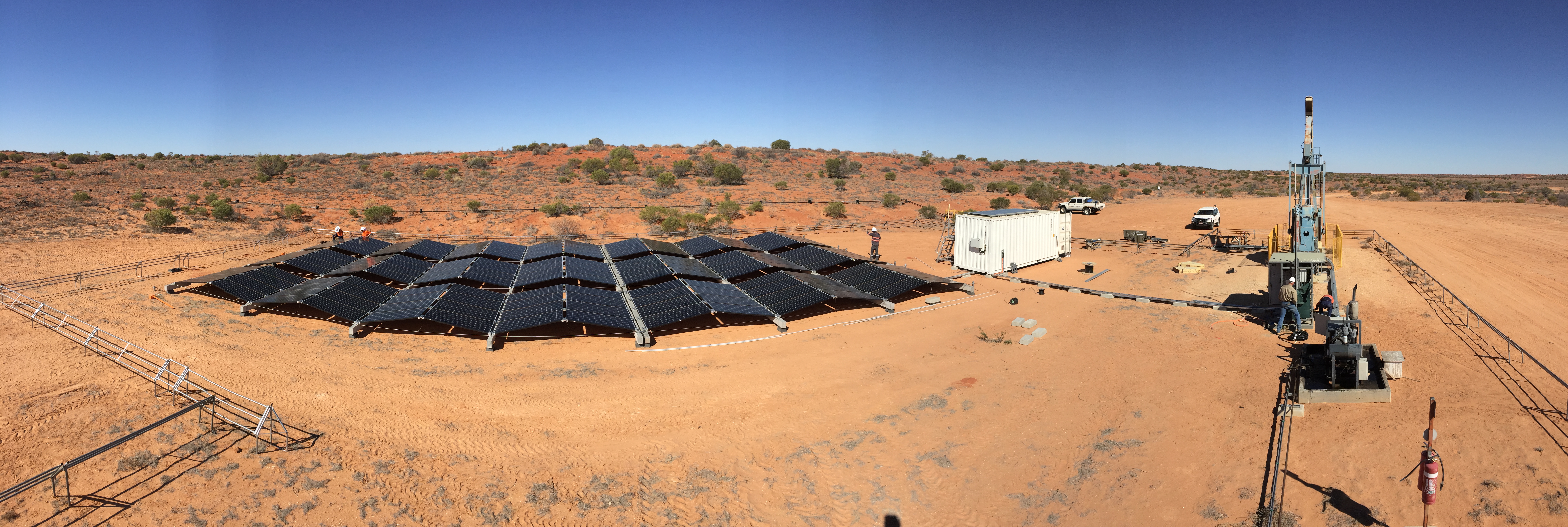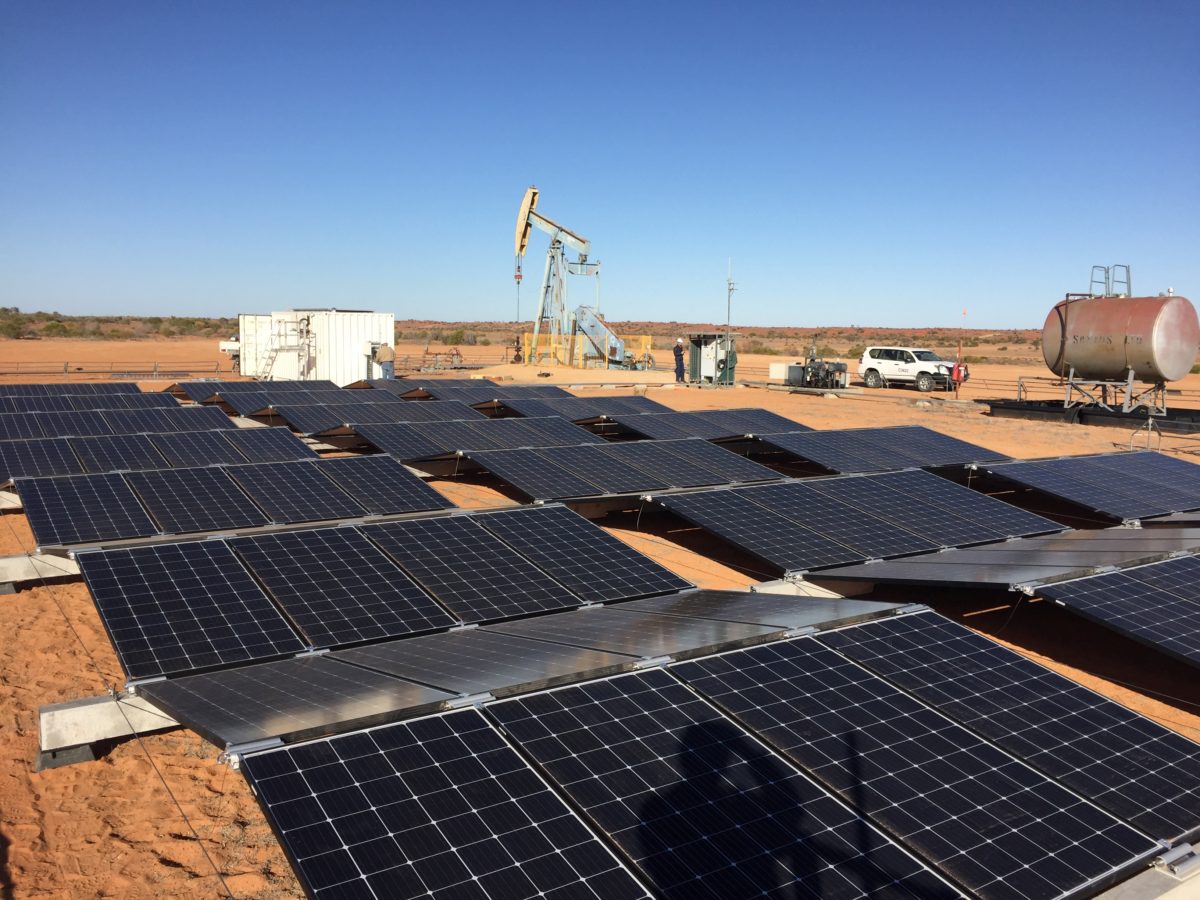Where South Australia borders southern Queensland and the Simpson and Sturt Stony Deserts rock and roil under the sun, beam pumps driven by diesel-powered generators labour night and day to tap Australia’s current most significant petrochemical resource.
Last year, Santos, the region’s largest oil and gas producer, with 208 beam pumps extracting oil alone, approached the Australian Renewable Energy Agency (ARENA) with a plan proposed by its Energy Solutions team: to test solar power as an alternative fuel to the 140 barrels (22,258 litres) of diesel fuel it uses daily to keep the pumps in motion.
Following a successful single pilot installation, which has now been running continuously since August 2018, ARENA in December committed $4.2 million or roughly a quarter of the $16 million cost of converting an initial 56 Santos remote beam pumps to solar-plus-battery power.
Ecoult batteries being used in the trial are key to the renewable combo’s non-stop operation. Ganesh Ganeshkumar, Manager of Business, Partners and Strategy for Ecoult in Australia and New Zealand was excited to tell pv magazine, “Working with AGL, Ecoult has successfully delivered a trial UltraBattery Energy Storage System to Santos’s renewable energy project in the Cooper Basin.”
The UltraBattery was developed 10 years ago by Smart Storage/Ecoult, then an offshoot of CSIRO, and has itself received ARENA development funding — under ARENA’s Emerging Renewables Program in 2013 ($554,000), and under Project Fulfil in 2017 ($4.1 million recoupable).
Now a wholly owned subsidiary of US-based East Penn lead-acid battery manufacturers, Ecoult’s breakthrough was to add longevity and flexibility to lead-acid technology by incorporating an ultra-capacitor.
Partial to rapid charging and discharging
“UltraBattery combines ultra-capacitor and lead-acid chemistries in a single electrolyte to create a hybrid cell that delivers excellent performance in a partial state of charge, with fast charging rates, high-energy density and exceptional lifetime throughput,” says Ganeshkumar.
Currently only two kinds of battery — lithium and UltraBattery — can operate in a partial state of charge. UltraBattery is suited to supporting variable renewable-energy supply because it is can rapidly and continuously charge and discharge without diminishing its efficiency over time. Its tolerance of temperatures up to 50 degrees Celsius without requiring cooling also suits Australian outback conditions.
“In a diesel-powered environment, cooling is particularly expensive and challenging to efficiency,” says Ganeshkumar, “so a battery that has tolerance to high temperatures increases the overall efficiency of the site”.
Ecoult’s remote web-based monitoring renders the UltraBattery extremely low maintenance. Where continuously run diesel generators can require monthly cleaning and maintenance, Ganeshkumar says that in its other off-grid applications, the UltraBattery Energy Storage System has required “only occasional maintenance over more than three years”.
Kevin Gallagher, Managing Director and CEO of Santos said at the start of the trial in December, that, “Renewables will help reduce costs over time not only by cutting our fuel consumption, but also by eliminating the costs of transporting fuel by road over long distances to our wells.”
For the time being, generators remain onsite at the trial wells, to ensure backup, but ultimately fuel and maintenance callouts will be all but eliminated by the new renewable infrastructure.
Although at this stage none of the participants would elaborate on the size of each of the solar PV systems, or the size of the batteries deployed, ARENA announced earlier that the 56 trial sites would be powered by a total of 3.2 MW of solar panels.

Image: Santos
At the launch of the trial, ARENA CEO Darren Miller said, “The project paves the way for Santos to convert further crude oil engine beam pumps in the Cooper Basin area, resulting in a significant part of their operations run entirely on renewables.”
Santos introduced emissions-reduction targets into its executive scorecards in 2018, and has set a long-term goal of net-zero emissions from its operations in 2050. It has also reported on its greenhouse gas emissions since 2004, with figures showing a steady growth in all of the company’s emissions since 2012; emissions from fuel used in its operations, for example, increased from 1.55 MtCO2e in 2012-13 to 3.19 MtCO2e in 2016-17.
In its Climate Change Report 2019, Santos committed to reducing all emissions across its Cooper Basin and Queensland operations by 5% (equal to 0.4 million tonnes of CO2e) by 2025, with the remainder of its reduction commitments tied to investigating solar-thermal technology for gas processing and carbon capture technologies; and exporting more liquefied natural gas from Australia, thereby potentially reducing the world’s reliance on higher polluting coal generation.
The report states: “If Australia’s forecast 85 million tonnes of liquefied natural gas exports replace legacy coal-fired power generation in Asia, then Australian liquefied natural gas reduces 300 million tonnes of global greenhouse gas emissions every year. To put this in context, this emissions reduction is three times the size of Australia’s annual emissions reduction target under the Paris Agreement.”
Clear and present opportunity
In the Cooper Basin, the immediate and clear opportunity offered by success of the ongoing solar-plus-battery trial, says Miller, is as a “test case for deployment to thousands of other sites in the Australian oil and gas sector as well as in other sectors in remote areas”.
If replacing 208 diesel generators can reduce crude-oil consumption by 140 barrels per day, the potential for emissions reductions across remote resources and community sites is substantial.
Adds Ganeshkumar, “While it may seem ironic to use PV and batteries to extract fossil fuels, for now we are all fossil fuel users in our cars, businesses and homes, so it’s a good step if we can reduce the cost and carbon impact of the extraction process.”
This content is protected by copyright and may not be reused. If you want to cooperate with us and would like to reuse some of our content, please contact: editors@pv-magazine.com.









4 comments
By submitting this form you agree to pv magazine using your data for the purposes of publishing your comment.
Your personal data will only be disclosed or otherwise transmitted to third parties for the purposes of spam filtering or if this is necessary for technical maintenance of the website. Any other transfer to third parties will not take place unless this is justified on the basis of applicable data protection regulations or if pv magazine is legally obliged to do so.
You may revoke this consent at any time with effect for the future, in which case your personal data will be deleted immediately. Otherwise, your data will be deleted if pv magazine has processed your request or the purpose of data storage is fulfilled.
Further information on data privacy can be found in our Data Protection Policy.